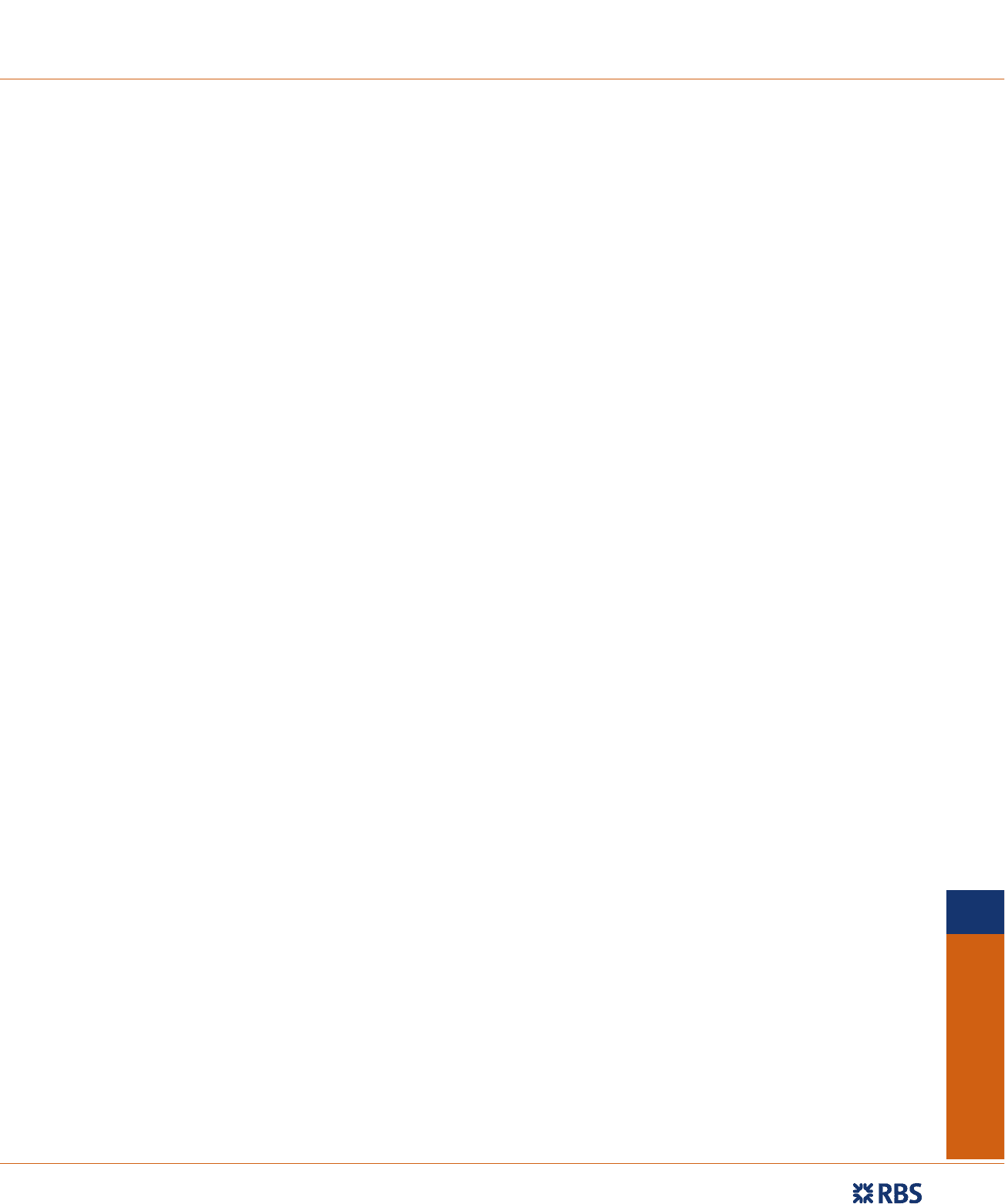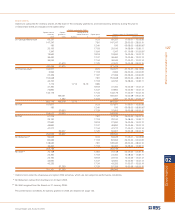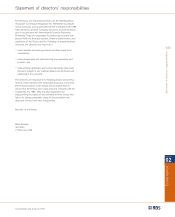RBS 2005 Annual Report Download - page 139
Download and view the complete annual report
Please find page 139 of the 2005 RBS annual report below. You can navigate through the pages in the report by either clicking on the pages listed below, or by using the keyword search tool below to find specific information within the annual report.
section
03
Financial
statements
137
Accounting policies
Annual Report and Accounts 2005
contingent liabilities are included in the consolidated accounts at
their fair value. Any excess of the cost (the fair value of assets
given, liabilities incurred or assumed and equity instruments
issued by the Group plus any directly attributable costs) of an
acquisition over the fair value of the net assets acquired is
recognised as goodwill. The interest of minority shareholders is
stated at their share of the fair value of the subsidiary’s net assets.
The results of subsidiaries acquired are included in the
consolidated income statement from the date control passes
to the Group. The results of subsidiaries sold are included up
until the Group ceases to control them.
All intra-group balances, transactions, income and expenses
are eliminated on consolidation. The consolidated accounts are
prepared using uniform accounting policies.
4. Revenue recognition
Interest income on financial assets that are classified as loans
and receivables, available-for-sale or held-to-maturity and
interest expense on financial liabilities other than those at fair
value through profit or loss are determined using the effective
interest rate method. The effective interest rate method is a
method of calculating the amortised cost of a financial asset
or financial liability (or group of financial assets or liabilities)
and of allocating the interest income or interest expense over
the expected life of the asset or liability. The effective interest
rate is the rate that exactly discounts estimated future cash
flows to the instrument’s initial carrying amount. Calculation of
the effective interest rate takes into account fees receivable,
that are an integral part of the instrument’s yield, premiums or
discounts on acquisition or issue, early redemption fees and
transaction costs. All contractual terms of a financial
instrument are considered when estimating future cash flows.
Financial assets and financial liabilities held-for-trading or
designated as at fair value through profit or loss are recorded
at fair value. Changes in fair value are recognised in profit or loss
together with dividends and interest receivable and payable.
Commitment and utilisation fees are determined as a percentage
of the outstanding facility. If it is unlikely that a specific lending
arrangement will be entered into, such fees are taken to profit
or loss over the life of the facility otherwise they are deferred
and included in the effective interest rate on the advance.
Fees in respect of services are recognised as the right to
consideration accrues through the provision of the service to
the customer. The arrangements are generally contractual and
the cost of providing the service is incurred as the service is
rendered. The price is usually fixed and always determinable.
The application of this policy to significant fee types is outlined
below.
Payment services: this comprises income received for payment
services including cheques cashed, direct debits, Clearing
House Automated Payments (the UK electronic settlement
system) and BACS payments (the automated clearing house
that processes direct debits and direct credits). These are
generally charged on a per transaction basis. The income is
earned when the payment or transaction occurs. Payment
services income is usually charged to the customer’s account,
monthly or quarterly in arrears. Accruals are raised for services
provided but not charged at period end.
Card related services: fees from credit card business include:
Commission received from retailers for processing credit
and debit card transactions: income is accrued to the
income statement as the service is performed.
Interchange received: as issuer, the Group receives a fee
(interchange) each time a cardholder purchases goods and
services. The Group also receives interchange fees from
other card issuers for providing cash advances through its
branch and Automated Teller Machine networks. These fees
are accrued once the transaction has taken place.
An annual fee payable by a credit card holder is deferred
and taken to profit or loss over the period of the service i.e.
12 months.
Insurance brokerage: this is made up of fees and commissions
received from the agency sale of insurance. Commission on the
sale of an insurance contract is earned at the inception of the
policy as the insurance has been arranged and placed. However,
provision is made where commission is refundable in the event of
policy cancellation in line with estimated cancellations.
Investment management fees: fees charged for managing
investments are recognised as revenue as the services are
provided. Incremental costs that are directly attributable to
securing an investment management contract are deferred and
charged as expense as the related revenue is recognised.
Insurance premiums – see note 11 below.
5. Pensions and other post-retirement benefits
The Group provides post-retirement benefits in the form of
pensions and healthcare plans to eligible employees.
For defined benefit schemes, scheme liabilities are measured on
an actuarial basis using the projected unit credit method and
discounted at a rate that reflects the current rate of return on a
high quality corporate bond of equivalent term and currency to
the scheme liabilities. Scheme assets are measured at their fair
value. Any surplus or deficit of scheme assets over liabilities is
recognised in the balance sheet as an asset (surplus) or liability
(deficit). The current service cost and any past service costs
together with the expected return on scheme assets less the
unwinding of the discount on the scheme liabilities is charged to
operating expenses. Actuarial gains and losses are recognised
in full in the period in which they occur outside profit or loss and
presented in the statement of recognised income and expense.
Contributions to defined contribution pension schemes are
recognised in the income statement when payable.
6. Intangible assets and goodwill
Intangible assets that are acquired by the Group are stated at
cost less accumulated amortisation and impairment losses.
Amortisation is charged to profit or loss using methods that
best reflect the economic benefits over their estimated useful
























